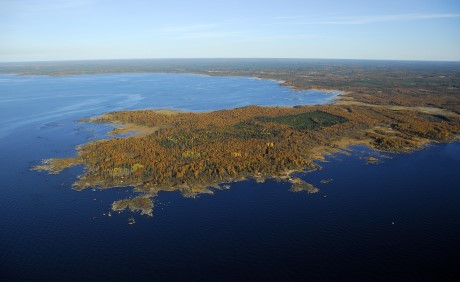Fennovoima has submitted an environmental impact assessment (EIA) for its proposed 1200 MWe Hanhikivi 1 nuclear power plant to Finland's Ministry of Employment and Economy (MEE).
 |
| The Hanhikivi site (Image: Fennovoima) |
The EIA considers the impacts of the construction and operation of a 1200 MWe Rosatom-supplied VVER pressurised water reactor at the site, which is in the municipality of Pyhäjoki on Finland's western coast. Although the Finnish government issued a decision-in-principle in favour of a new plant there in 2010, it was based on Fennovoima's initial plans for an 1800 MWe plant using either an Areva EPR or Toshiba ABWR. However, in 2013 Fennovoima decided to pursue a mid-sized reactor instead and the MEE directed the company to update its EIA accordingly.
Decision-in-principle
Minister of Economic Affairs Jan Vapaavuori said the assessments would proceed as planned. "Based on these reports, a legal position will be taken on whether or not the existing decision-in-principle also covers the Rosatom option, or if the decision-in-principle made by the Parliament in 2010 should be reconsidered," he said.
As well as assessing the environmental impacts of the proposed 1200 MWe reactor, the EIA compares them with the impacts of the 1800 MWe plant from earlier proposals as well as looking at the impacts of a "zero option" of building no new unit at all. It concludes that construction of the 1200 MWe unit is environmentally "feasible" for the Pyhäjoki site.
Impacts on water systems, fishery, flora, fauna and conservation areas were found to be slightly lower for the 1200 MWe plant, which would also produce lower volumes of operating waste and used fuel.
According to the EIA, a "zero option" of not building the plant, but instead producing the same amount of electricity by other means, would likely result in increases to Finland's electricity imports. As replacement electricity would most likely be from coal-fired plants, this would also result in increased emissions of carbon dioxide, sulfur dioxide and nitrogen oxides.
The MEE is now soliciting opinions on the report from various bodies and a public hearing process will also take place before a final ministerial statement is issued. The is scheduled to be issued in June.
Researched and written
by World Nuclear News




_18570.jpg)
_18938.jpg)
_33584.jpg)
_82983.jpg)





